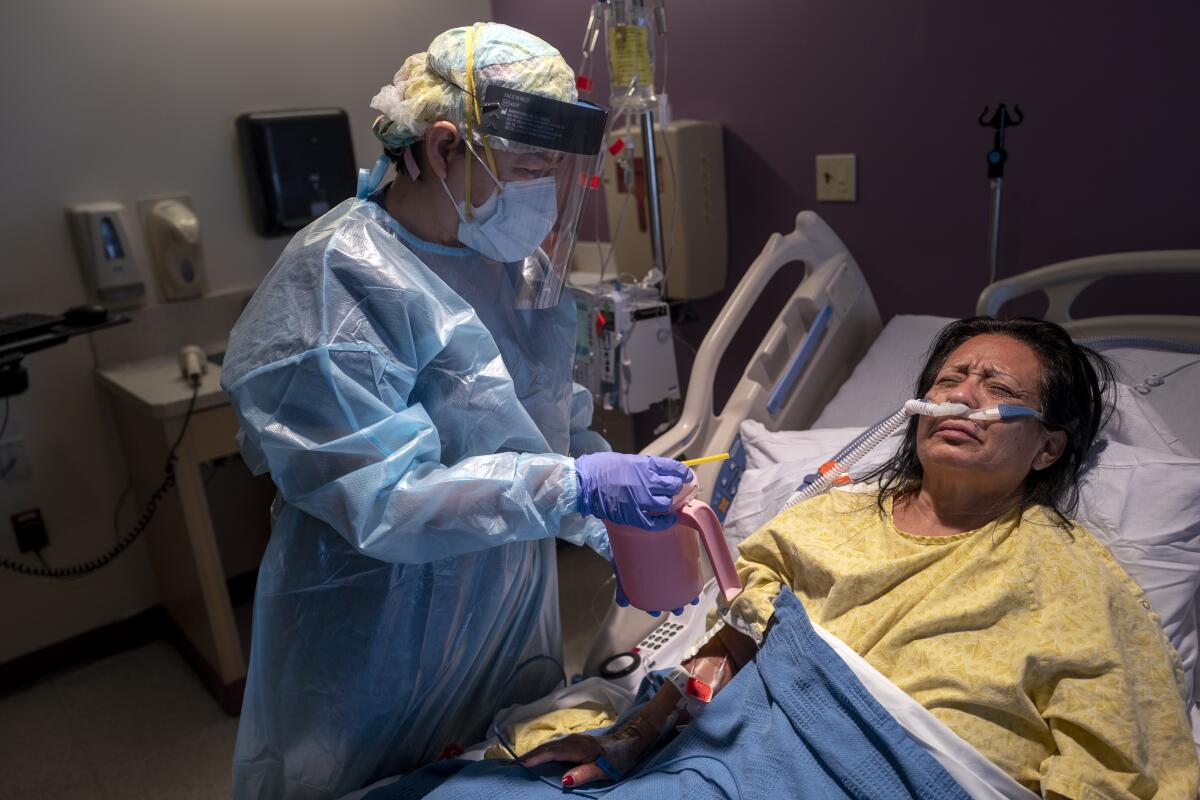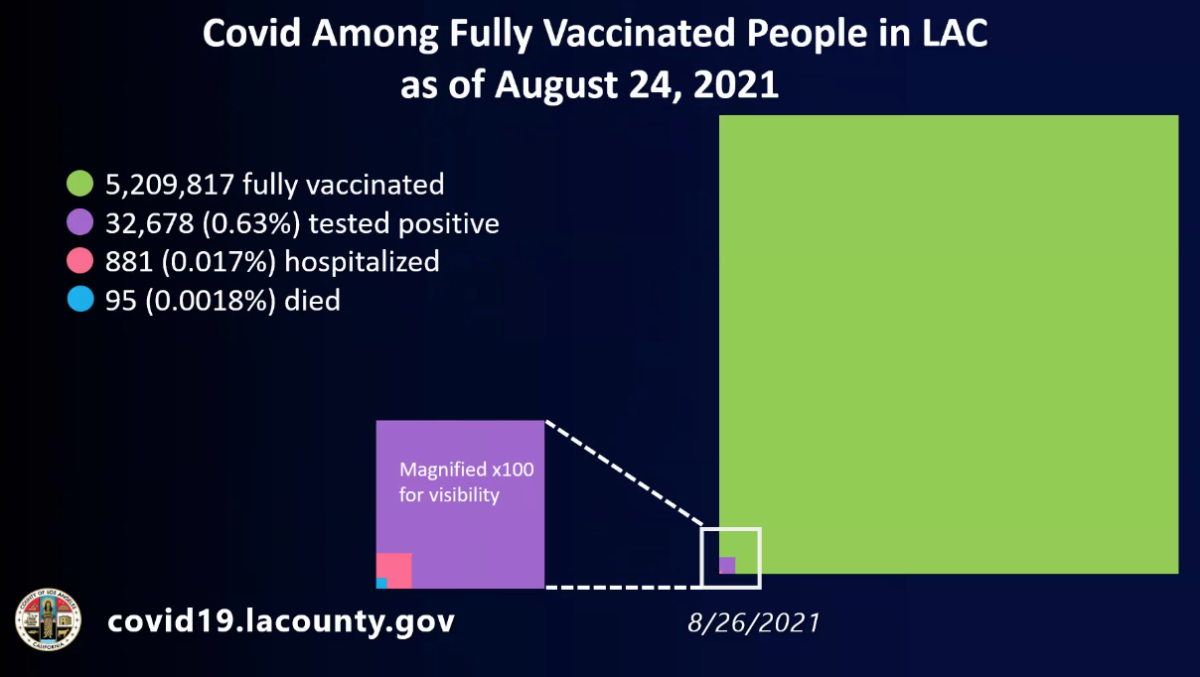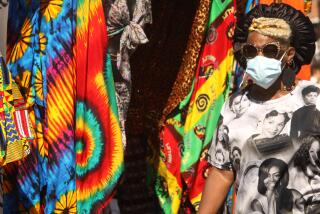COVID-19 cases rising among unvaccinated youth, Latinos in L.A. County

- Share via
Los Angeles County has seen a slowdown in the latest surge in COVID-19 patients headed to hospitals, but it is unclear yet whether it has gotten past another peak, Barbara Ferrer, director of the county public health department, said Thursday.
It’s “hard to know,” Ferrer said, cautioning that “we have a lot of risk right now” as many people return to their routines and children and teachers go back to school with the highly transmissible Delta variant circulating in the county.
Ferrer said coronavirus cases have dropped in L.A. County by about 15% in the past week, but she cautioned that the numbers would remain relatively high as more people get routine testing for the virus.
Despite the recent decline, cases have kept rising among unvaccinated children and teens, some of whom are too young to be eligible for the shots. In recent weeks, weekly case rates among unvaccinated children and teens rose from 73 to 307 cases per 100,000, Ferrer said.
Unvaccinated adults in L.A. County still remain more likely to be infected with the coronavirus than children. For every 100,000 unvaccinated adults age 50 or older, 399 contracted the coronavirus over a recent week; among unvaccinated younger adults, 510 did. And hospitalization and death rates from COVID-19 remain much lower among children than adults.
Vaccinated people had a much lower risk of contracting the coronavirus. Unvaccinated younger adults had four times the risk of testing positive for the coronavirus compared with their vaccinated counterparts, while unvaccinated older adults had five times the risk.
Ferrer said the early data on schools have been “somewhat sobering.”
Between Sunday and Wednesday, five school outbreaks have been identified involving 27 students and three staff members, who exposed 135 others. By comparison, last week, when many schools reopened for the fall semester, three outbreaks were identified, involving 25 students and 60 staff members, who exposed 79 others.
Increased transmission of the virus among children was expected because “as they get back to school and their other activities, there’s just a lot more contact,” Ferrer said.
“The issue for us is to make sure that we mitigate against a significant increases in cases by taking appropriate actions where possible,” Ferrer said, including making sure that school children wear masks indoors and getting teens and adults vaccinated.
She also recommended wearing masks in crowded situations outdoors.
“If we want to see a reduction in the number of children that are getting infected, we’re going to have to do a lot — starting with all the adults around them and the teens around them need to get fully vaccinated. That really lessens the chance of transmission to your child or someone else’s child,” Ferrer said.
Both case and hospitalization rates have also surged among unvaccinated Latinos, according to county figures. Ferrer said she was concerned to see that the case rate for the group had increased by 200% over the last month and that the department would be looking into the possible causes.
Deaths, which lag behind cases and hospitalizations as a sign of whether the virus is waxing or waning, have risen about 6% over the past week, Ferrer said. About 18 COVID-19 deaths are now being reported per day.
In Los Angeles County, there were 1,723 patients hospitalized with confirmed cases of COVID-19, including 451 in intensive care, according to the latest state figures. It was the second day in a row that hospitalizations have dropped after an uptick earlier this week, trends that officials have watched closely.
On the state level, California reported Thursday that 8,265 patients were hospitalized with confirmed cases of the virus, with 1,982 people in intensive care.
The latest figures mark a slight decrease from the previous day, but remain at far higher levels than mid-July, when fewer than 3,000 patients across California were hospitalized with confirmed cases of the virus.
The numbers in L.A. County and statewide seem to have started to stabilize in recent weeks, said Dr. Timothy Brewer, professor of epidemiology at the UCLA Fielding School of Public Health.
“Potentially that’s a sign that things may be slowly starting to move in the right direction,” Brewer said. Whether COVID-19 resurges in the fall — a common characteristic of viruses spread by respiratory droplets — will depend on vaccination rates and other protective steps such as masks and distancing.
“If people continue to take those steps, then we won’t necessarily have a big rise in respiratory viruses,” he said.
The summer surge has strained California hospitals a year and a half into the pandemic.
“We can find the space for beds and for patients. The challenge is finding the staff to take care of them,” said Jan Emerson-Shea, spokesperson for the California Hospital Assn. As healthcare workers suffer burnout, “some are taking extended leaves of absences because they need to recharge. Some are leaving hospital work altogether.”
Hospitals can seek state waivers from required nurse-to-patient ratios, postpone some medical procedures, or try to hire from a coveted pool of traveling nurses — if they can snag them — but the staffing strain could also lead to longer waits in emergency rooms, she said.
Nursing unions have also faulted hospitals nationally for driving workers away, arguing that the problem predates the COVID-19 pandemic. In a statement Thursday, National Nurses United said that the hospital industry was “crying false tears ... when these untenable working conditions are entirely of their own making.”
More than 64% of Californians have gotten at least one dose of a COVID-19 vaccine and 56% are fully vaccinated, according to a Times tracker. Vaccination rates have been highest in the Bay Area and have lagged behind in the northernmost areas of the state and the San Joaquin Valley.
Despite concerns about breakthrough cases among vaccinated people, health officials have continued to stress that the vaccines provide strong protection against severe illness and death. A Centers for Disease Control and Prevention study found that as of July 25, unvaccinated people were 4.9 times more likely to get infected with the virus and 29.2 times more likely to be hospitalized than fully vaccinated people in L.A. County.
The reality is that “the vaccines do not provide 100% protection from infections, hospitalizations, or deaths,” particularly when community transmission is high, Ferrer said. But “fully vaccinated people continue to be extraordinarily well protected from hospitalizations and they continue to be very unlikely to die from COVID.”
As of Tuesday, only 0.63% of fully vaccinated people in L.A. County had tested positive for the virus, 0.017% had been hospitalized, and 0.0018% had died — a total of 95 deaths across the county.

Vaccinated patients who were hospitalized were much more likely than their unvaccinated counterparts to have chronic conditions to put them at higher risk, such as Type 2 diabetes and high blood pressure, a county review found.
To clamp down on the virus, many California employers have insisted that workers get vaccinated. Los Angeles recently passed an ordinance mandating that city employees get the shots by Oct. 5 unless they are approved for a medical or religious exemption. L.A. is also weighing another measure that would require people to be at least partially vaccinated to enter indoor restaurants, bars and other venues.
Both have spurred sharp opposition from L.A. workers and residents who are reluctant to get vaccinated. One L.A. firefighter, wearing an LAFD hat and shirt, recorded a video of himself excoriating the mandate for city employees and said he and other firefighters had retained an attorney. The video prompted an investigation into whether he violated city rules.
Newly released results from an Associated Press-NORC Center for Public Affairs Research poll found that 50% of working people surveyed were in favor of requiring employees who are going in person to a workplace to be fully vaccinated against COVID-19, with 52% favoring mask requirements in the workplace.
The numbers were higher when pollsters asked whether people favored vaccine mandates for specific categories of workers, including healthcare workers, K-12 teachers, employees who interact with the public, military and government workers.
The virus has pummeled people in poorer communities, with overall death rates more than three times higher in the poorest neighborhoods in L.A. County than the richest ones, according to county figures.
Black and Latino residents of L.A. County have died of the virus at higher rates than white and Asian residents over the course of the pandemic. In a recent week, however, Ferrer noted that the death rates for unvaccinated white adults and teens in the county had surpassed those of other unvaccinated groups.
Homeless people have also been hit by the latest surge. Between Aug. 16 and Aug. 22, the public health department investigated seven outbreaks affecting unhoused people, five of them in homeless shelters. During the pandemic, the majority of the more than 8,100 homeless people known to have gotten COVID-19 were sheltered, including over 1,800 people in emergency shelters, according to a recent report.
More to Read
Sign up for Essential California
The most important California stories and recommendations in your inbox every morning.
You may occasionally receive promotional content from the Los Angeles Times.












